
Big Ridge State Park
Encyclopedia
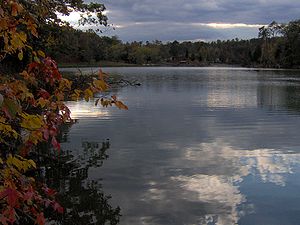
State park
State parks are parks or other protected areas managed at the federated state level within those nations which use "state" as a political subdivision. State parks are typically established by a state to preserve a location on account of its natural beauty, historic interest, or recreational...
in Union County, Tennessee, in the southeastern United States. The park consists of 3687 acres (14.9 km²) on the southern shore of the Norris Reservoir
Norris Lake
Norris Lake may refer to:* Norris Lake, a Tennessee Valley Authority reservoir in Tennessee, impounded by Norris Dam* Lake Norris in Lake County, Florida...
, an impoundment of the Clinch River
Clinch River
The Clinch River rises in Southwest Virginia near Tazewell, Virginia and flows southwest through the Great Appalachian Valley, gathering various tributaries including the Powell River before joining the Tennessee River in East Tennessee.-Course:...
created by the completion of Norris Dam
Norris Dam
Norris Dam is a hydroelectric and flood control structure located on the Clinch River in Anderson County and Campbell County, Tennessee, USA. Its construction in the mid-1930s was the first major project for the Tennessee Valley Authority, which had been created in 1933 to bring economic...
in 1936. Much of the park's recreational focus is on Big Ridge Lake, a 45 acre (0.1821087 km²) sub-impoundment of Norris near the center of the park.
Big Ridge State Park was first developed by the Tennessee Valley Authority
Tennessee Valley Authority
The Tennessee Valley Authority is a federally owned corporation in the United States created by congressional charter in May 1933 to provide navigation, flood control, electricity generation, fertilizer manufacturing, and economic development in the Tennessee Valley, a region particularly affected...
(TVA), the National Park Service
National Park Service
The National Park Service is the U.S. federal agency that manages all national parks, many national monuments, and other conservation and historical properties with various title designations...
and the Civilian Conservation Corps
Civilian Conservation Corps
The Civilian Conservation Corps was a public work relief program that operated from 1933 to 1942 in the United States for unemployed, unmarried men from relief families, ages 18–25. A part of the New Deal of President Franklin D...
(CCC) in the 1930s as part of the greater Norris Project. The park was one of three of the project's demonstration recreational areas that eventually became state parks (Norris Dam State Park
Norris Dam State Park
Norris Dam State Park is a state park in Anderson County and Campbell County, Tennessee, in the southeastern United States. The park is situated along the shores of Norris Lake, an impoundment of the Clinch River created by the completion of Norris Dam in 1936. The park consists of managed by...
and Cove Lake State Park
Cove Lake State Park
Cove Lake State Park is a state park in Campbell County, Tennessee, in the southeastern United States. The park consists of situated around Cove Lake, an impoundment of Cove Creek created by the completion of Caryville Dam in 1936...
are the other two). The park's recreational facilities opened in May 1934. The park is now operated and maintained by the Tennessee Department of Environment and Conservation
Tennessee Department of Environment and Conservation
The Tennessee Department of Environment and Conservation is a Cabinet-level agency within the government of the U.S. state of Tennessee, headed by the Tennessee Commissioner of Environment and Conservation....
.
Geographical setting
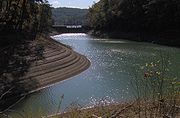
Ridge-and-valley Appalachians
The Ridge-and-Valley Appalachians, also called the Ridge and Valley Province or the Valley and Ridge Appalachians, are a physiographic province of the larger Appalachian division and are also a belt within the Appalachian Mountains extending from southeastern New York through northwestern New...
, which is characterized by narrow elongate ridges flanked by fertile stream valleys. The park's topography is dominated by three such ridge systems running roughly parallel to one another, the two northernmost of which are bisected by the Big Ridge Lake inlet of Norris Lake. The northernmost ridge is known as "Lone Mountain" west of the inlet and "Big Ridge" east of the inlet. The central ridge is known as "Bluebird Ridge" west of the inlet and "Pinnacle Ridge" east of the inlet. The southernmost ridge, which is not bisected by the inlet, is known as "Chestnut Ridge." The northern and central ridge systems are divided by Dark Hollow, a narrow valley that spans the entire park. The central and southern ridges are divided by a valley known as Blue Mud Valley west of the inlet and Poor Land Valley east of the inlet.
The Clinch River flows southwestward from its source in Virginia
Virginia
The Commonwealth of Virginia , is a U.S. state on the Atlantic Coast of the Southern United States. Virginia is nicknamed the "Old Dominion" and sometimes the "Mother of Presidents" after the eight U.S. presidents born there...
through much of northeastern Tennessee before emptying into the Tennessee River
Tennessee River
The Tennessee River is the largest tributary of the Ohio River. It is approximately 652 miles long and is located in the southeastern United States in the Tennessee Valley. The river was once popularly known as the Cherokee River, among other names...
near Kingston
Kingston, Tennessee
Kingston is a city in and the county seat of Roane County, Tennessee, United States, and is adjacent to Watts Bar Lake. Kingston, with a population of 5,264 at the 2000 United States census, is included in the Harriman, Tennessee Micropolitan Statistical Area....
. Norris Dam, located 80 miles (128.7 km) upstream from the Clinch's mouth, retains a reservoir that spans a 73 miles (117.5 km) stretch of the river and covers nearly 34000 acres (137.6 km²). Big Ridge State Park is located 99 miles (159.3 km) above the river's mouth, at the confluence of the Clinch River and Mill Creek. The two streams converge at a mile-wide section of the lake known as Loyston Sea, named after the community of Loyston
Loyston, Tennessee
Loyston was a community in Union County, Tennessee, USA, that was inundated by the waters of Norris Lake after the completion of Norris Dam in 1935. Established in the early 19th century around a foundry built by its namesake, John Loy, over subsequent decades the community's location along State...
which was once situated in the lower Mill Creek valley.
The water gap between Lone Mountain and Big Ridge became a narrow inlet with the creation of Norris Lake. The inlet, which joins the south side of Loyston Sea, stretches southward for just over a mile before forking at a knob known as Loyston Overlook. Big Ridge Dam, a 50 feet (15.2 m) spillway
Spillway
A spillway is a structure used to provide the controlled release of flows from a dam or levee into a downstream area, typically being the river that was dammed. In the UK they may be known as overflow channels. Spillways release floods so that the water does not overtop and damage or even destroy...
dam, impounds the eastern leg of this fork, forming the 45 acre (0.1821087 km²) Big Ridge Lake.
Natural information
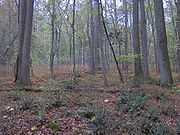
Paleozoic
The Paleozoic era is the earliest of three geologic eras of the Phanerozoic eon, spanning from roughly...
-age rocks created from ancient ocean sediments several hundred million years ago. Limestone formations are common in the valleys and hollows, whereas more resistant sandstone and shale formations are common along the ridges. Dolomitic limestone caps are occasionally found on some of the more blunt ridgetops. The ridges themselves were created 200-300 million years during the Appalachian orogeny. The soil in the area is relatively shallow and early farmers considered it poor for growing crops.
Most of Big Ridge State Park is coated in a second-growth southern hardwood
Hardwood
Hardwood is wood from angiosperm trees . It may also be used for those trees themselves: these are usually broad-leaved; in temperate and boreal latitudes they are mostly deciduous, but in tropics and subtropics mostly evergreen.Hardwood contrasts with softwood...
forest, with oak
Oak
An oak is a tree or shrub in the genus Quercus , of which about 600 species exist. "Oak" may also appear in the names of species in related genera, notably Lithocarpus...
, hickory
Hickory
Trees in the genus Carya are commonly known as hickory, derived from the Powhatan language of Virginia. The genus includes 17–19 species of deciduous trees with pinnately compound leaves and big nuts...
, tuliptree, and basswood being the most common species. Table mountain pine
Table Mountain Pine
Pinus pungens, the Table Mountain Pine, is a small pine native to the Appalachian Mountains in the United States. Table Mountain Pine, Pinus pungens, is also called Hickory Pine or Mountain Pine, though the latter name usually refers to the European species Mountain Pine - Pinus...
, shortleaf pine
Shortleaf Pine
Pinus echinata is a species of pine native to the eastern United States from southern New York south to northern Florida, west to the extreme southeast of Kansas, and southwest to eastern Texas. The tree is variable in form, sometimes straight, sometimes crooked, with an irregular crown...
, and red cedar
Juniperus virginiana
Juniperus virginiana is a species of juniper native to eastern North America, from southeastern Canada to the Gulf of Mexico, east of the Great Plains...
are found in drier areas and along ridge slopes. Wildlife species include white-tail deer, beaver
Beaver
The beaver is a primarily nocturnal, large, semi-aquatic rodent. Castor includes two extant species, North American Beaver and Eurasian Beaver . Beavers are known for building dams, canals, and lodges . They are the second-largest rodent in the world...
, heron
Heron
The herons are long-legged freshwater and coastal birds in the family Ardeidae. There are 64 recognised species in this family. Some are called "egrets" or "bitterns" instead of "heron"....
, and wood duck
Wood Duck
The Wood Duck or Carolina Duck is a species of duck found in North America. It is one of the most colourful of North American waterfowl.-Description:...
. Migrating bald eagle
Bald Eagle
The Bald Eagle is a bird of prey found in North America. It is the national bird and symbol of the United States of America. This sea eagle has two known sub-species and forms a species pair with the White-tailed Eagle...
s and golden eagle
Golden Eagle
The Golden Eagle is one of the best known birds of prey in the Northern Hemisphere. Like all eagles, it belongs to the family Accipitridae. Once widespread across the Holarctic, it has disappeared from many of the more heavily populated areas...
s are occasionally spotted in winter. Big Ridge Lake is home to several species of fish, including bluegill
Bluegill
The Bluegill is a species of freshwater fish sometimes referred to as bream, brim, or copper nose. It is a member of the sunfish family Centrarchidae of the order Perciformes.-Range and distribution:...
, largemouth bass
Largemouth bass
The largemouth bass is a species of black bass in the sunfish family native to North America . It is also known as widemouth bass, bigmouth, black bass, bucketmouth, Potter's fish, Florida bass, Florida largemouth, green bass, green trout, linesides, Oswego bass, southern largemouth...
, spotted bass
Spotted bass
The Spotted Bass , also called "Spotty", "Leeman", or "Spots" in various fishing communities, is a species of freshwater fish sunfish family of order Perciformes. One of the black basses, it is native to the Mississippi River basin and across theGulf States, from central Texas through the Florida...
, crappie
Crappie
Crappie is a genus of freshwater fish in the sunfish family of order Perciformes. The type species is P. annularis, the white crappie...
, flathead catfish
Flathead catfish
The flathead catfish , also called the yellow cat, opelousas, and shovelhead cat, are large North American freshwater catfish. This is the only species of the genus Pylodictis...
, and freshwater drum
Freshwater Drum
-Introduction:The freshwater drum, Aplodinotus grunniens, is a fish endemic to North and Central America. It is the only species in the genus Aplodinotus. The Freshwater drum is a member of the family Sciaenidae, and is the only member of the species that inhabits freshwater for its entire life...
.
Early history
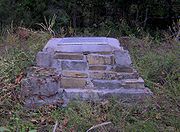
Smithsonian Institution
The Smithsonian Institution is an educational and research institute and associated museum complex, administered and funded by the government of the United States and by funds from its endowment, contributions, and profits from its retail operations, concessions, licensing activities, and magazines...
conducted an extensive archaeological survey of the region and located nearly two dozen prehistoric Native American
Native Americans in the United States
Native Americans in the United States are the indigenous peoples in North America within the boundaries of the present-day continental United States, parts of Alaska, and the island state of Hawaii. They are composed of numerous, distinct tribes, states, and ethnic groups, many of which survive as...
sites. At a site known as the Hill Farm Stone Mounds approximately 2 miles (3.2 km) northeast of Loyston, excavators uncovered a townhouse with a clay seat and altar, a floor covered with sand and clay, and postholes suggesting that it was constructed using small upright logs thatched together with grass and cane. At the confluence of the Clinch and Powell rivers, approximately 5 miles (8 km) northwest of the present park boundary, archaeologists excavated a mound nearly 60 feet (18.3 m) in diameter. The excavation revealed a townhouse-like structure with a clay seat and a circular clay fireplace. These structures likely date to the Mississippian period
Mississippian culture
The Mississippian culture was a mound-building Native American culture that flourished in what is now the Midwestern, Eastern, and Southeastern United States from approximately 800 CE to 1500 CE, varying regionally....
(c. 1000-1500 A.D.). By the time the first European explorers arrived in the region in the 18th century, the Cherokee
Cherokee
The Cherokee are a Native American people historically settled in the Southeastern United States . Linguistically, they are part of the Iroquoian language family...
were in control of the area.
In 1761, a group of long hunters led by Elisha Walden hunted in the Clinch and Powell valleys from a station camp in southwestern Virginia. The long hunting expeditions of the 1760s were followed by a flood of settlers in the 1770s and 1780s. As trans-Appalachian migration increased in the waning years of the American Revolution
American Revolutionary War
The American Revolutionary War , the American War of Independence, or simply the Revolutionary War, began as a war between the Kingdom of Great Britain and thirteen British colonies in North America, and ended in a global war between several European great powers.The war was the result of the...
, small forts sprang up throughout the Tennessee Valley to provide migrants with rest stops and protect local settlers from hostile Cherokee attacks. In the 1780s, a German pioneer named Henry Sharp (1735–1814) established Sharp's Station on the banks of the Clinch in what is now the northern section of Big Ridge State Park. Peter Graves, a settler living at Sharp's Station, was ambushed and killed atop Big Ridge in November of 1794. Sharp's Station itself was attacked the following month, although the settlers successfully fought off the attackers. Sharp's descendants were still in possession of the land when TVA began buying up the property in the 1930s.
The community of Loyston (initially known as Loy's Crossroads), now under the lake just north of the park, was established by John Loy in the early 19th century. The Loy and Sharp families both operated iron furnaces using ore mined along Big Ridge, creating mostly tools and household items. By the early 20th century, Loyston had grown into a regional trading center for the Big Ridge area.
The Norris Project

Civilian Conservation Corps Company 4495, which was originally based in Loyston, began work on Big Ridge State Park in October 1934. The CCC built several rustic cabins, the sandy beach, a lodge, and restored the circa-1825 Norton Gristmill
Gristmill
The terms gristmill or grist mill can refer either to a building in which grain is ground into flour, or to the grinding mechanism itself.- Early history :...
. TVA and the CCC constructed Big Ridge Dam during this period so that the park would have a lake area not affected by seasonal drawdowns of the Norris Reservoir.
The park today
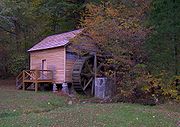
Easter egg
Easter eggs are special eggs that are often given to celebrate Easter or springtime.The oldest tradition is to use dyed or painted chicken eggs, but a modern custom is to substitute chocolate eggs, or plastic eggs filled with confectionery such as jelly beans...
hunt held the day before Easter
Easter
Easter is the central feast in the Christian liturgical year. According to the Canonical gospels, Jesus rose from the dead on the third day after his crucifixion. His resurrection is celebrated on Easter Day or Easter Sunday...
, a Bluegrass music
Bluegrass music
Bluegrass music is a form of American roots music, and a sub-genre of country music. It has mixed roots in Scottish, English, Welsh and Irish traditional music...
festival held the third Friday in August, and night hikes and ghost storytelling sessions led by park rangers on Friday and Saturday nights in October.
Over 15 miles (24.1 km) of hiking trails criss-cross the ridges and hollows connecting all sections of the park. The 1.5 miles (2.4 km) Lake Trail follows the shore of Big Ridge Lake, connecting the Visitor Center area with Big Ridge Dam. The trail provides access to Meditation Point— a small hill topped by a sheltered bench— and the Loyston Overlook. The 1.7 miles (2.7 km) Big Valley Trail follows an old road over Pinnacle Ridge, connecting the Norton Gristmill area with Dark Hollow. The West and East Dark Hollow trails traverse the entirety of Dark Hollow between Big Ridge and Pinnacle Ridge. The 2.6 miles (4.2 km) Indian Rock Loop crosses the crest of Big Ridge past Indian Rock before descending the steep northern slope of the ridge to the Sharp's Station area. The 1.2 miles (1.9 km) Ghost House Loop passes Norton Cemetery and an area traditionally believed to be haunted.
The Norton Gristmill is the park's most prominent historical feature. The mill was built in 1825 by Tink McCoy and later purchased by Lewis Norton. The mill is now mostly a replica, although the original mill race and millstones remain. Other historical features include Indian Rock, atop Big Ridge, where a plaque marks the site of the 1794 ambush of Peter Graves. A small monument at the now-disinterred Lon Sharp Cemetery in the northeast section of the park recalls the 18th-century Sharp's Station, which was believed to have been located near the cemetery. Norton Cemetery houses the grave of Maston Hutcheson (1826–1910), who according to local lore is responsible for hauntings in the area. A few minor remains of Hutcheson's house are still visible at the junction of the Ghost House Loop Trail and the Big Valley Trail connector.
External links
- http://www.tennessee.gov/environment/parks/BigRidge/

